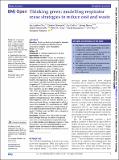| dc.contributor.author | Chu, Jacqueline N | |
| dc.contributor.author | Ghenand, Omkar | |
| dc.contributor.author | Collins, Joy | |
| dc.contributor.author | Byrne, James D | |
| dc.contributor.author | Wentworth, Adam J | |
| dc.contributor.author | Chai, Peter | |
| dc.contributor.author | Dadabhoy, Farah Z. | |
| dc.contributor.author | Hur, Chin | |
| dc.contributor.author | Traverso, Giovanni | |
| dc.date.accessioned | 2021-07-20T14:34:59Z | |
| dc.date.available | 2021-07-20T14:34:59Z | |
| dc.date.issued | 2021-07 | |
| dc.date.submitted | 2021-01 | |
| dc.identifier.issn | 1556-5068 | |
| dc.identifier.uri | https://hdl.handle.net/1721.1/131111 | |
| dc.description.abstract | Objectives To compare the impact of respirator extended use and reuse strategies with regard to cost and
sustainability during the COVID-19 pandemic.
Design Cost analysis.
Setting USA.
Participants All healthcare workers within the USA.
Interventions Not applicable.
Main outcome measures A model was developed to estimate usage, costs and waste incurred by several
respirator usage strategies over the first 6 months of the pandemic in the USA. This model assumed universal
masking of all healthcare workers. Estimates were taken from the literature, government databases and
commercially available data from approved vendors. Results A new N95 respirator per patient encounter
would require 7.41 billion respirators, cost $6.38 billion and generate 84.0 million kg of waste in the USA over
6 months. One respirator per day per healthcare worker would require 3.29 billion respirators, cost $2.83 billion
and generate 37.22 million kg of waste. Decontamination by ultraviolet germicidal irradiation would require 1.64
billion respirators, cost $1.41 billion and accumulate 18.61 million kg of waste. H₂O₂ vapour decontamination
would require 1.15 billion respirators, cost $1.65 billion and produce 13.03 million kg of waste. One reusable
respirator with daily disposable filters would require 18 million respirators, cost $1.24 billion and generate 15.73
million kg of waste. Pairing a reusable respirator with H₂O₂ vapour-decontaminated filters would reduce cost to $831 million and generate 1.58 million kg of waste. The use of one surgical mask per healthcare worker per day would require 3.29 billion masks, cost $460 million and generate 27.92 million kg of waste.
Conclusions Decontamination and reusable respirator-based strategies decreased the number of respirators
used, costs and waste generated compared with single-use or daily extended-use of disposable respirators. Future development of low-cost, simple technologies to enable respirator and/or filter decontamination is needed to further minimise the economic and environmental costs of masks. | en_US |
| dc.publisher | Elsevier BV | en_US |
| dc.relation.isversionof | http://dx.doi.org/10.1136/bmjopen-2021-048687 | en_US |
| dc.rights | Creative Commons Attribution NonCommercial License 4.0 | en_US |
| dc.rights.uri | https://creativecommons.org/licenses/by-nc/4.0/ | en_US |
| dc.source | BMJ Open | en_US |
| dc.title | Thinking Green: Respirator Reuse Strategies to Reduce Cost and Waste | en_US |
| dc.type | Article | en_US |
| dc.identifier.citation | Chu, Jacqueline N. et al. "Thinking Green: Respirator Reuse Strategies to Reduce Cost and Waste." BMJ Open 11, 7 (July 2021): e048687. © 2021 Author(s) | en_US |
| dc.contributor.department | Koch Institute for Integrative Cancer Research at MIT | en_US |
| dc.contributor.department | Massachusetts Institute of Technology. Department of Biological Engineering | en_US |
| dc.contributor.department | Massachusetts Institute of Technology. Department of Mechanical Engineering | en_US |
| dc.relation.journal | BMJ Open | en_US |
| dc.eprint.version | Final published version | en_US |
| dc.type.uri | http://purl.org/eprint/type/JournalArticle | en_US |
| eprint.status | http://purl.org/eprint/status/PeerReviewed | en_US |
| dspace.date.submission | 2021-07-19T13:40:32Z | |
| mit.journal.volume | 11 | en_US |
| mit.journal.issue | 7 | en_US |
| mit.license | PUBLISHER_CC | |
| mit.metadata.status | Complete | |
